UnaliWear, Kanega Watch : Review
By: Editorial Team | Posted: February 9, 2021 | Updated: October 21, 2025
The Basics
- Product: Kanega Watch
- Company: UnaliWear
- Review Date: Q1 2021. Updated Dec. 2023.
Where to buy it or learn more*:
Discount for Tech-enhanced Life readers:
- Discount code: Techenhanced
- Discount amount: 1 free month
Analyst Summary: UnaliWear | Kanega Watch
The Kanega Watch incorporates the key features of a conventional medical alert into the format of a watch — and tells the time.
In our opinion, this product aims squarely at a quite specific set of wants / needs:
- I want a “mobile medical alert” that looks like a piece of consumer electronics but still has all the expected features of a medical alert, including fall detection; and
- I want a medical alert I can wear 24/7 because I worry about accidents that might happen when I take it off to charge.
In addition, it includes a voice activated interface (as well as a more conventional button).
This product is one of several products we compared in a piece of research called “Smartwatch as Medical Alert“. If you are interested in this category of product, we recommend you look at that comparative review.
We think of the UnaliWear Kanega Watch as straddling two product categories: the “smartwatch medical alert” and the more conventional “mobile medical alert”. For more on the latter, see: “Mobile Medical Alerts: Comparative Evaluation“.
The Pluses
We think this product is best thought of as an attempt to take a conventional medical alert, and “fix” some of the things wrong with other products in the category.
The basic functionality is really that of a medical alert, with some extra features and some rather significant cosmetic improvements. So, for example:
- it includes an automatic fall detection algorithm (which was rare in medical alerts that are on the wrist rather than in a pendant form, when it was first introduced although less so in 2024);
- one press of the button on the side of the watch will initiate a call to the professional monitoring service that comes with the watch.
- Unlike many mobile medical alerts, it can send out its “call for help” over both the cellular network (typical of competitors), and the WiFi network in your house (see discussion below under “works everywhere”).
In addition:
- it includes the ability to interact by voice with the watch in several ways. For example, you can ask it to call for help (without pressing anything); and you can ask it to tell you the time or day (without needing to press anything or look at anything).
- it has a rather novel and unusual approach to charging and battery management (see below).
- It does NOT look like a conventional medical alert, or a typical “old person’s product”, which is a definite plus.
- it includes a capability of setting medication reminders.
If you want a product that you can literally wear for 24/7, because you worry that falls happen at night and in the shower, and don’t want to take the alert off, then this is one of the few medical alerts that make that possible. This is because you do NOT need to take it off to charge, unlike most of the competitors. See the section on charging and battery below for details.
The Minuses
Depending on what you need, there are some aspects of the product that could be negatives.
- Although we include this in the category of “smartwatches as medical alerts”, it is light on smartwatch features. It does not have capabilities like fitness tracking or weather, although it does have a conventional watch face so you can tell the time. It also includes medication reminders.
- In our hands-on exploration of this product by the Longevity Explorers, some of the women felt it was “too big” to wear comfortably, and a “bit clunky”. Some were just fine with it, however, and most of the men thought its size was fine. See the section below on appearance for images so you can decide for yourself.
In our testing, this product performed significantly less well than some of the competitors when it came to “connecting with the responder when you call for help“. See the “Works Everywhere” section below for more detail, as well as the comparison article for how this product and its competitors performed in “calling for help”.
The Details
For lots more details about this product, including the topics below, we suggest you read “Smartwatch as Medical Alert?“.
In Smartwatch as Medical Alert? we discuss topics including:
- charging;
- can you wear it in the shower?
- ease of use;
- where it does and does not work;
- response time;
- how well it can locate you;
- any “failures to call for help” in our testing;
- how this category of medical alert smartwatch compares with more conventional medical devices; and
- features for caregivers (like knowing where the wearer is).
Here are some additional items not fully addressed in our comparative evaluation: Smartwatch as Medical Alerts.
Charging and Batteries
The most unusual aspect of this product is the way it gets charged.
Unlike most smartwatches or medical alerts, you do not plug the watch itself into a charger. Nor do you place it on a magnetic charging stand.
Instead, the product has two batteries that clip into the “band”, and can fairly easily be unclipped. The idea is that once a day you unclip the batteries, and then replace them with two other batteries (it comes with four batteries).
When not in use, the two spare batteries clip into a charging stand, and get charged.
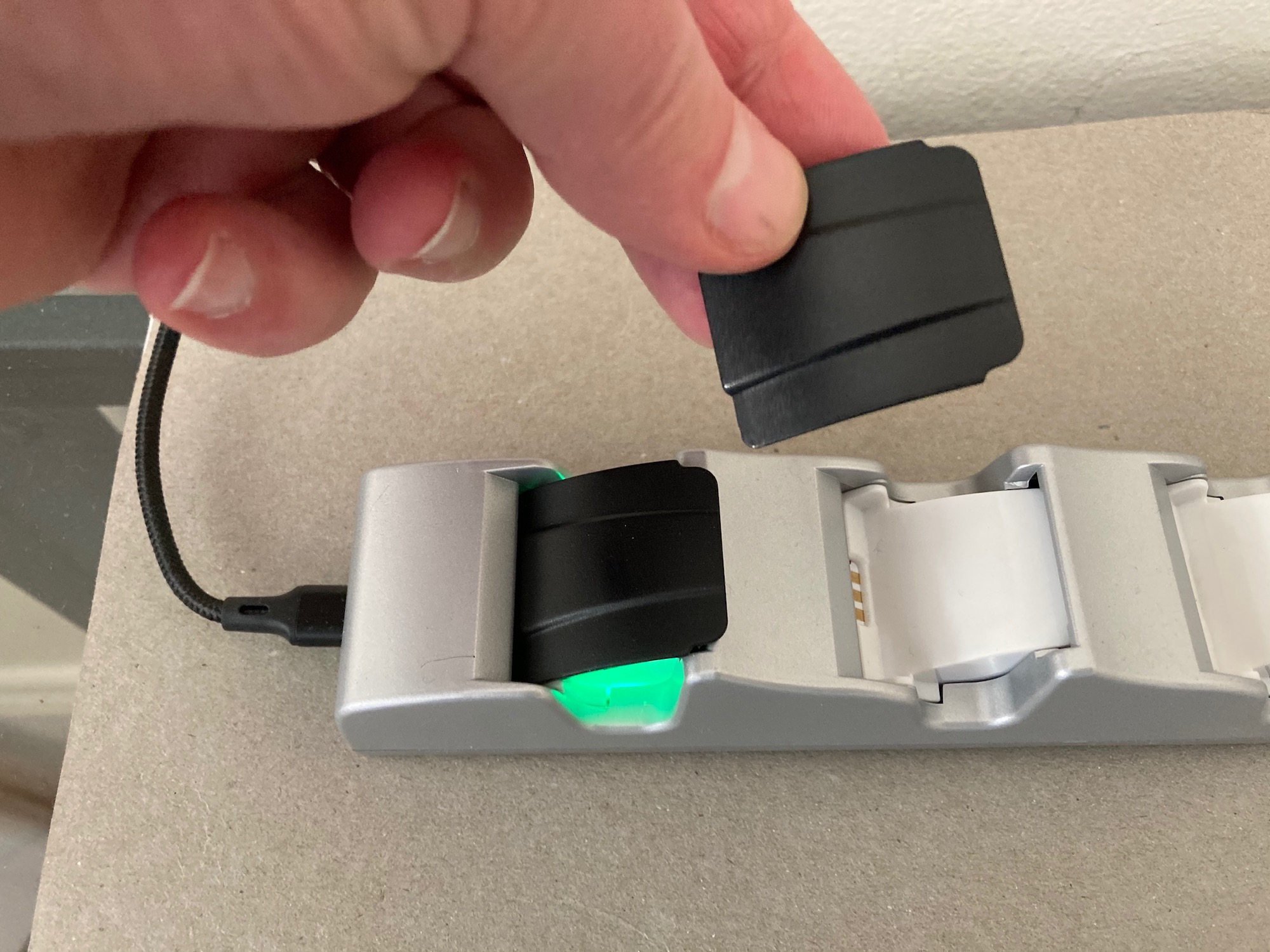
Caption: Charging station (gray) and two batteries (black) with one inserted and one about to be inserted in charging station.
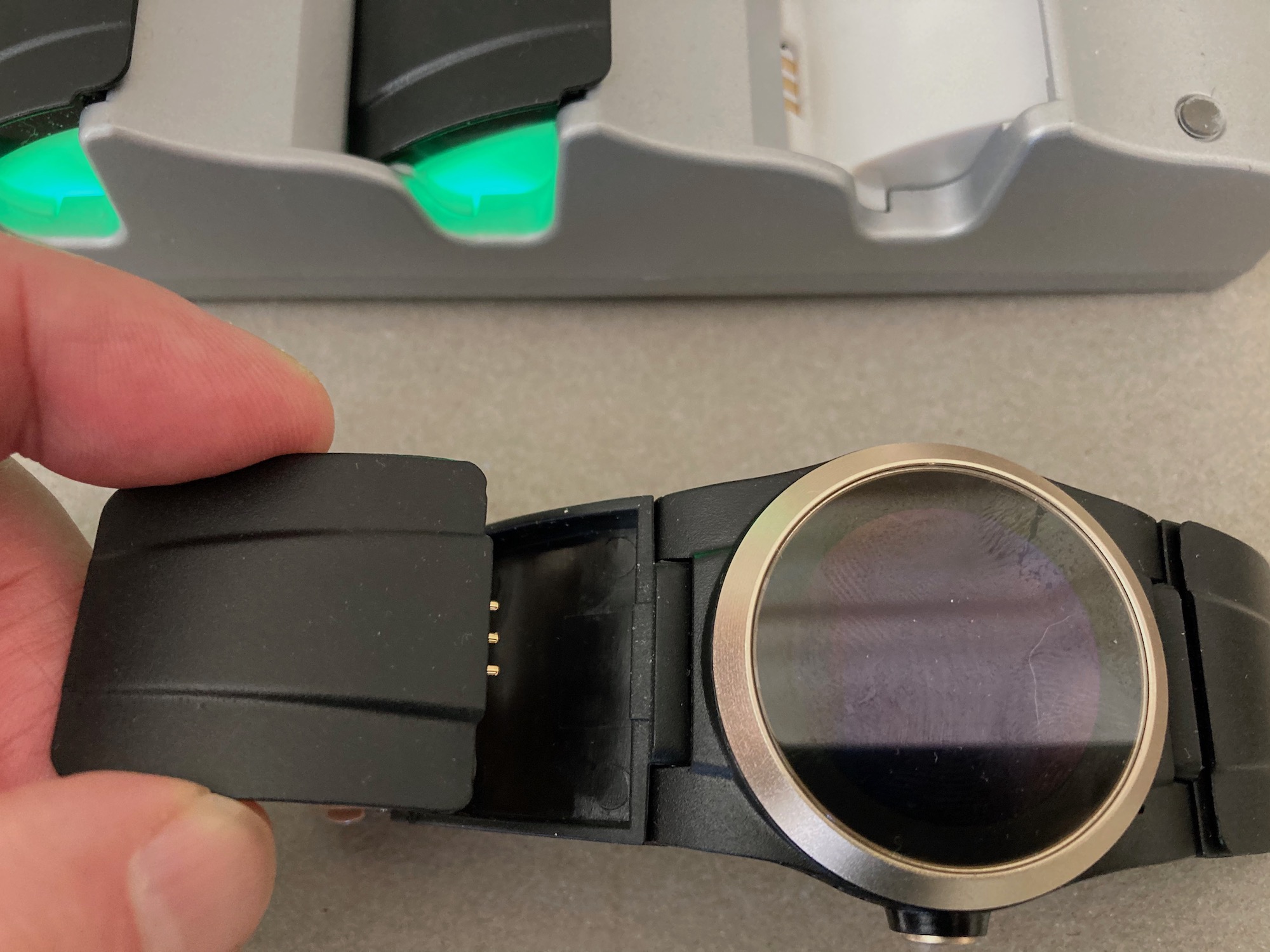
Caption: Battery about to be inserted into Kanega watch
There are advantages and disadvantages to this approach.
- You basically NEVER need to take off the watch. Instead, you just replace the batteries daily, which you can do easily without taking off the watch.
- BUT, as a result the “band” is quite chunky and large, although not “heavy”. This leads to a very distinctive look, which got mixed responses from the Longevity Expolorers.
- Replacing the batteries requires some fine motor dexterity — and of course requires you (or a carer) to remember (although the watch speaks reminders to you when charging is needed).
If you want a medical alert you basically never need to take off, this accomplishes that. And this is a definite contrast to most medical alerts that require you to take off the device daily and place it in the charging stand.
The reason some people care about this is that many falls happen at night on the way to the bathroom, or in the shower, and those are exactly the times when you might have taken off your alert to let it charge.
In addition to the above, the watch also includes an additional internal battery that can keep the watch going for a period even when the normal batteries have lost charge. According to the company, the internal battery can keep the watch going for 15 minutes of “call time”, or “hours” if not actually “calling”.
Appearance and Ease of Use
The Kanega Watch has a nice OLED display, which is quite bright.
However, we noticed some pixelation on the digital “time” numbers, and felt the “fine print” (for example day and date) on the primary screen were rather small. However, these are small “negatives” in the scheme of things.
The screen is NOT a touchscreen. To change things on the watch you either use voice commands, or you use “presses” of the crown button to move through menus.
- For everyday operation by the “older adult” this seemed rather easy.
- For “setting it up” or “changing stuff”, the interface seemed rather clunky with quite a few button presses. But this would presumably only be done once on initial setup, and be done by a carer rather than the older adult.
The product comes in three different color trims. Below are some images so you can decide how you feel about the “look and feel”.
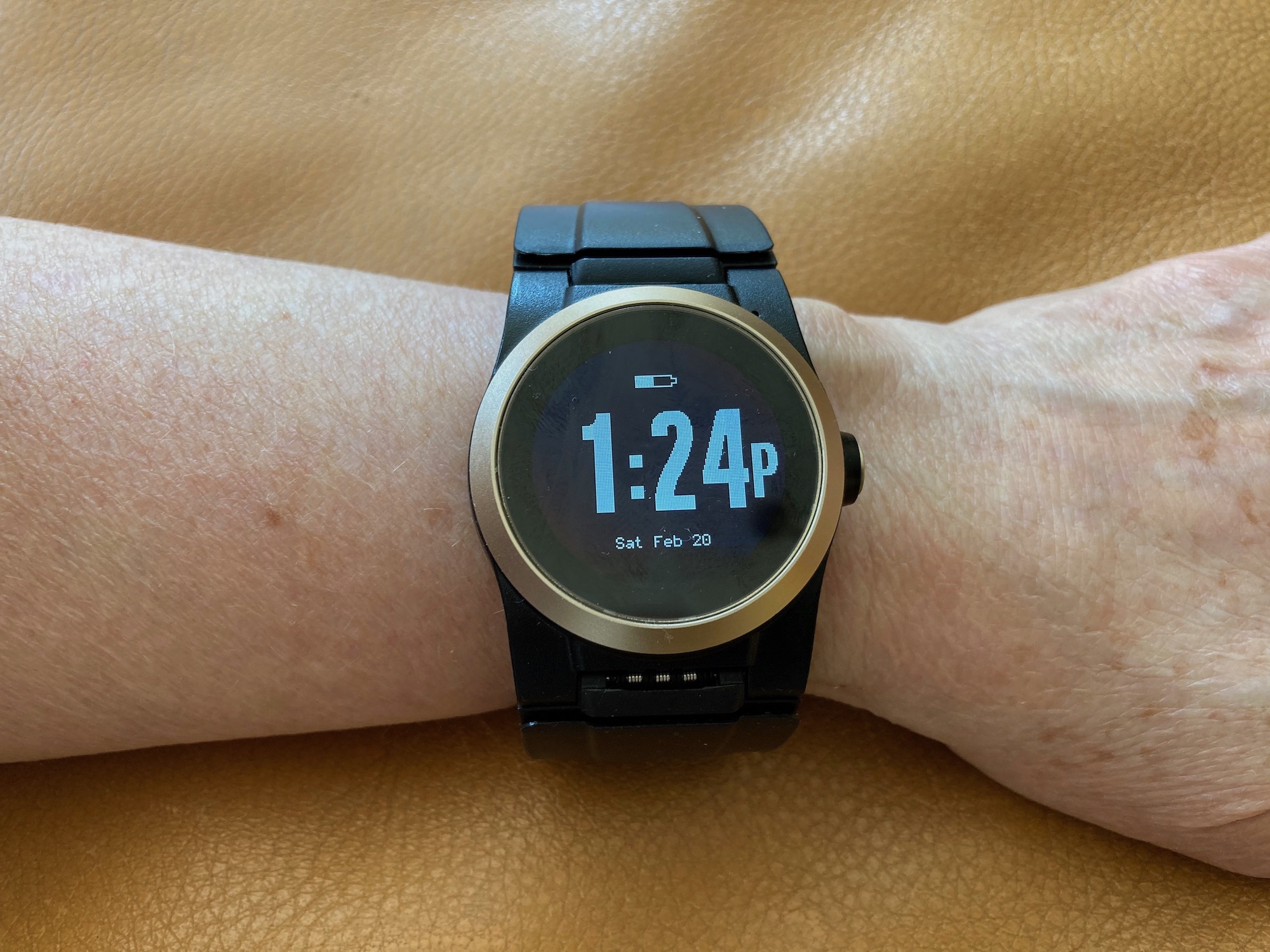
Caption: Kanega watch from above on wrist of small woman.
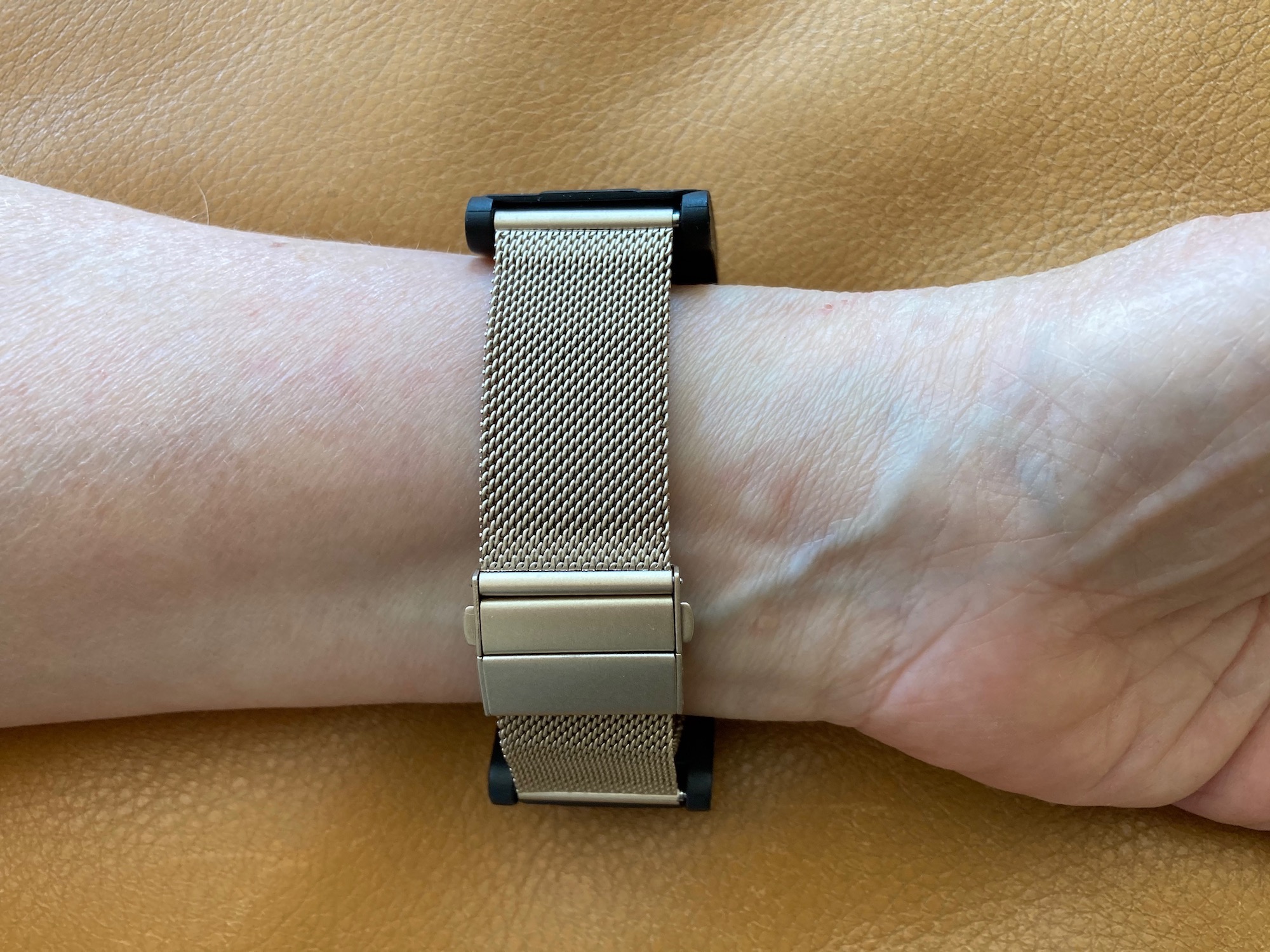
Caption: Kanega watch from below on wrist of small woman.
Voice Activation
One of the unusual characteristics of this product is that you can interact with it almost entirely by voice if you wish.
For example, you can ask it to call for help (without pressing anything); and you can ask it to tell you the time or day (without needing to press anything or look at anything).
As well as being relevant to people who find voice an easier way to interact than touch, this feature means that you can call for help even if the watch is not actually on your wrist — so long as it is close enough to talk to.
Like other voice activated devices, it requires a “wake word”, which for the one we received was “Fred Astaire”. A person would need to be able to remember the wake word.
Fall Detection
Incorporation of an automatic fall detection algorithm is a very important aspect of this product.
This is an important and useful feature, that means if you fall and hit your head and are unable to call for help, the device will detect that (so long as it works correctly), and initiate the call to the monitoring center.
The problem with all fall detection algorithms is the potential for false positives and other errors.
Traditional medical alerts often include a fall deletection capability too, but usually only when the device is worn around the neck as a pendant. The medical alert industry claims that it is “hard” to create a successful fall detection algorithm that works on the wrist.
Apple (Apple Watch) was the first to ship widely available products with a wrist-based fall detection algorithm. And now the Kanega watch has one too, as does the FallCall Lite app that can run on an Apple Watch.
As of our update in Dec. 2023, a number of other smartwatches have also added fall detection.
We have not attempted to evaluate the “perfection” of these different fall detection algorithms.
Works Everywhere
Like all mobile medical alerts, this product connects to the outside world via a cellular connection. However it can also connect via WiFi.
So, in our testing we needed to tell the company our WiFi password and when it arrived in our building it automatically connected to the outside world either via WiFi or cellular depending on which was available.
This is a rather nice feature. It means that if you have a house where there is poor cell connectivity in some or all rooms, it will still work fine so long as you have a WiFi network with good signal everywhere.
Then, when you go “out and about”, it will connect using the regular cell signal.
This also helps prolong the battery life (time between charges).
This product works on the Verizon cell network. However, unlike most medical alerts it uses a special cell network (LTE-CAT M1) designed for “Internet of Things” traffic rather than for regular voice calls.
This has two important consequences:
- It allows the product to use less power than it would if it ran on the normal voice network, thus enabling a longer battery life;
- BUT, in our tests we found the product less good at actually “making the voice connection with the responder” than its competitors (see below). And the company explained this is likely a consequence of the specific network they are using.
Failure to Connect & Response Time
In our testing around San Francisco, we found that the quality of the cell connection to the responder after pressing the alert button was sometimes disappointing. For example, in 3 out of 10 “calls”, the voice connection to the responder was so poor we could not really have a conversation.
When we discussed that with the company, they explained that due to the specific nature of the network, they expected that the actual data would likely always go through, even if the voice quality was poor. So, for example, the responders would know you had pressed the emergency button, and would have the information about where you are, even though they might not be able to establish a good voice connection with you.
We did not evaluate how correct this was for our situation.
This is definitely a negative for this product. We think being able to talk with the responder after you call for help is important.
However it needs to be set against the benefits of battery life which it enables. And the company has included a WiFi connection for use in the home that gets around this issue when at home (the call goes over the WiFi network if WiFi is available).
CAVEAT: This is based on limited testing and limited different locations, and network quality depends very strongly on exactly where you are. If you like the other features of the product, which are quite unusual, we recommend trying it for yourself, and reporting back in the comments. It is encouraged to test the system regularly and that will help you find out how well it works in your specific location.
For the tests which led to successful connections, we found the total “time to connect” was a little slower than competing products. For example, in our tests, the average time to connect (ignoring those where connection failed completely) for the Kanega Watch was 90 seconds. In contrast, several of the other products had average response times in the range of 30-45 seconds.
The designers appear to have traded off raw speed for a nice feature in which the product makes several verbal “checks” to be sure you are not about to make a call inadvertently.
Vision & Hearing Issues
The voice interaction mode could be extremely helpful for people with vision impairment.
For people with “normal” vision, but with the normal older adult vision issues (like a need for reading glasses, and some loss of contrast perception), we found the screen OK but not ideal. The brightness seemed to vary automatically, but it was not always at a level we found comfortable or easy to use. In some situations, it seemed a bit dim. In others, it seemed rather good.
For people with hearing issues, there were no special features. The loudness and clarity compared to competing products is covered in Smartwatch as Medical Alert.
Caregiving App
As of December 2023 the Kanega Watch does NOT come with any sort of “caregiver app”, which means a carer can not see where the wearer of the watch is, although the “monitoring center” does know where the watch is.
Pricing
- For current pricing, see the vendor’s website (links below).
- For a table comparing pricing of this product and the others in our comparative analysis at the time of our evaluations, see Smartwatch as Medical Alert: Pricing.
Where to buy it or learn more*: (this takes you away from our website)
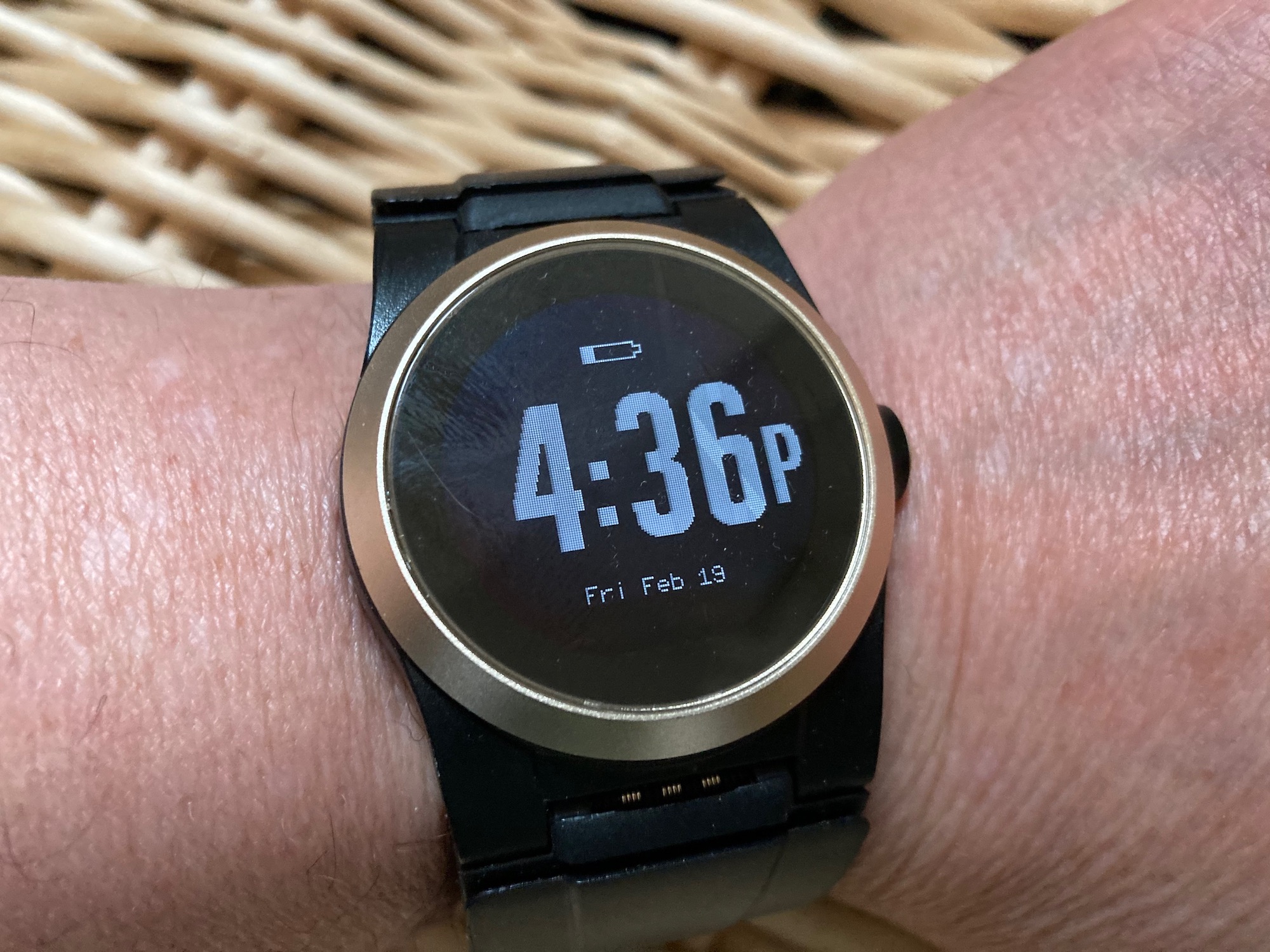
Discount for Tech-enhanced Life readers:
- Discount code: Techenhanced
- Discount amount: 1 free month
*Disclosure: The research and opinions in this article are those of the author, and may or may not reflect the official views of Tech-enhanced Life.
If you use the links on this website when you buy products we write about, we may earn commissions from qualifying purchases as an Amazon Associate or other affiliate program participant. This does not affect the price you pay. We use the (modest) income to help fund our research.
In some cases, when we evaluate products and services, we ask the vendor to loan us the products we review (so we don’t need to buy them). Beyond the above, Tech-enhanced Life has no financial interest in any products or services discussed here, and this article is not sponsored by the vendor or any third party. See How we Fund our Work.
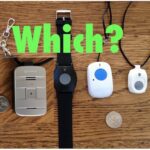
I have used my kanega watch
I have used my kanega watch for almost 3 years adding a safety net for my active life. I am a walker , hiker and gardener and and I like that if I fall or have any accident when I am alone a monitoring company is alerted 24/7. I got compliments on the look of the watch and changing the batteries is easy as the watch is charged all the time. My husband recently had heart surgery and he is wearing a kanega watch too as well as my sister. We all feel the watch is a life saver!
Nancy Powell
Researched many safety alert
Researched many safety alert devices for my mom. She hated the pendant type because of its appearance and daily removal for charging. Not always on her mind to charge another device. Ordered the Kanega watch from UnaliWear in November, 2022. It is simple to use and rarely needs removing so she can’t say “I forgot to put it on”. It has performed all of the services UnaliWear Kanega Watch claims, and the duties my mom and I required she have in place in case of any emergency. As the daughter, I can recommend this safety watch to ease a caregiver’s mind when they can’t be on top of a loved one 24/7. As for my mom, she wears it always and it reminds her to make safe choices in order to be able to continue to live in HER home.
Hi Susan,
Hi Susan,
Thank you so much for your thoughtful review. We are so happy that the Kanega Watch is providing your Mom and you with the peace of mind you both deserve. We will share your review internally with our team to inspire all of us as we seek to bring Independence with Dignity to more people like your Mom throughout the country. All the best to you and your Mom and stay well and safe 🙂